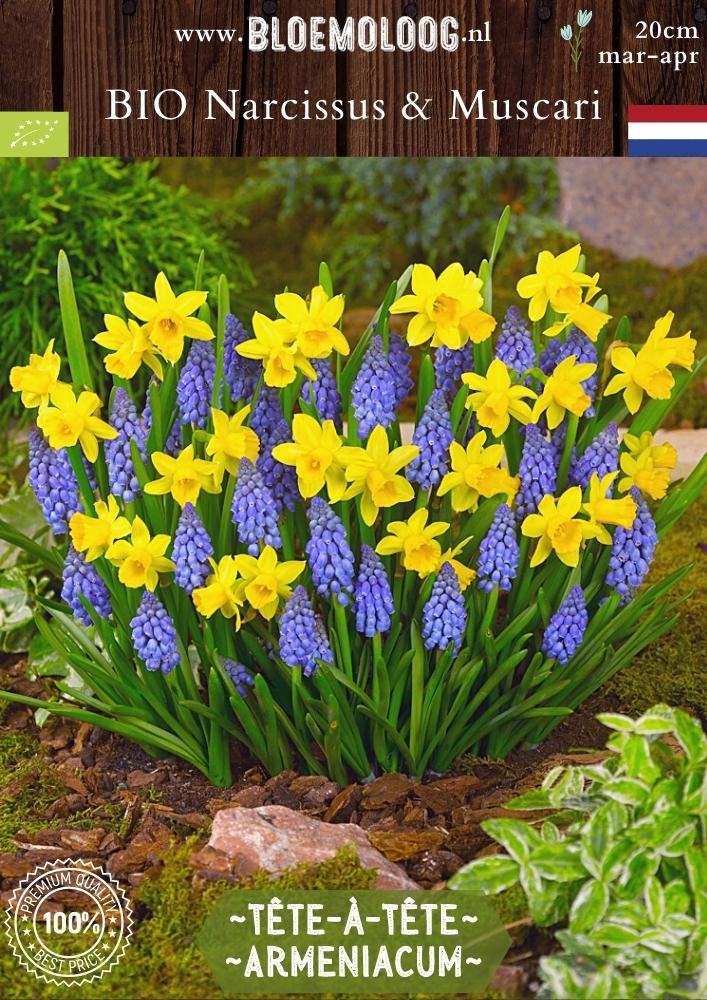Bloemoloog
Organic Narcissus 'Tête-à-Tête' & Muscari 'Armeniacum' mix | 20 pcs.
Organic Narcissus 'Tête-à-Tête' & Muscari 'Armeniacum' mix | 20 pcs.
Estimated Shipping Widget will be displayed here!
Couldn't load pickup availability
Organic daffodil and grape hyacinth mix
A popular mix that is often offered in pots and bowls at the garden center. Grow your own bulb basket with at least these two extremely strong varieties in it!
The Bloemoloog® has selected for you:
- 10 Organic Narcissus 'Tête-à-Tête'
- 10 Organic Muscari 'Armeniacum'
This mix contains 10 of both types, packed separately, so that you can plant them nicely together in groups. It also gives a nice effect to plant these organically grown daffodils and muscari together. Just how you want!
How, where and when do I plant flowerbulbs of grape hyacinths and daffodils?
Muscaris and daffodils are flowerbulbs that need a cold period. The flowerbulbs are planted in the autumn from September so that they are in the ground during the winter and get that cold period. When planting, maintain 2 to 3 times the height of the flowerbulb itself and in terms of width, maintain 2 to 3 times the width of the flowerbulb.
Plant them in a warm, sunny to slightly shaded spot. Plant it in groups in a nutrient-rich, water-permeable, preferably calcareous, sandy soil, but it will also grow in clay soil. As long as the soil is well-drained and does not retain excess water. If you have clay soil, you can improve the soil by adding organic matter such as compost or well-rotted manure to improve drainage.
Daffodil bulbs are poisonous, which is why they are avoided by rodents such as voles. Use them as a natural protection for other flowerbulbs by planting them around and between the other bulbs.
Care of the daffodil
To preserve the energy of the plants, it is important to remove spent flowers. This prevents the plant from wasting energy on seed formation. After the flowers have finished blooming, it is important to allow the foliage of the plant to die back completely. The foliage should turn yellow and wilt before cutting. This gives the flowerbulb the opportunity to store nutrients for the next year.
Propagation
Muscaris and daffodils propagate via seed and produce many small breeding balls every year. For propagation, the flowerbulbs are removed from the ground at the beginning of summer, divided and can be planted again immediately.
Buy Organic Daffodil and Grape hyacinth mix
Skal NL-BIO-01 certified: 109459
Packed per 20 flower bulbs or choose a stacking discount!
Stacking discount: E
Can be ordered from June '25!
EU shipping €8.95 - Free shipping from €100 purchase.
Characteristics
| Flowering time: | March - April |
| Planting time: | From September |
| Planting depth: | 10 cm underground |
| Planting distance: | 10 cm apart |
| Height: | 20 cm high |
| Flower diameter: |
5cm wide |
| Location: | Partial shade, sun |
| Soil PH: | Loam, sandy soil - Slightly acidic/neutral |
| Winter hardiness: | Good hardy |
| Propagation: | Good (naturalizes) |
| Family: | Amaryllidaceae (daffodil family) & Asparagaceae (asparagus family) |
| Colour: |
Yellow and blue |
| Bee-friendly: | Yes |
| Fragrant: | Yes |
| Bulb size: | 8/9 - 11+ |

NL-BIO-01
To share


